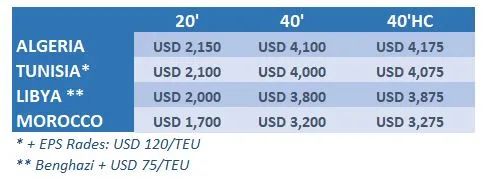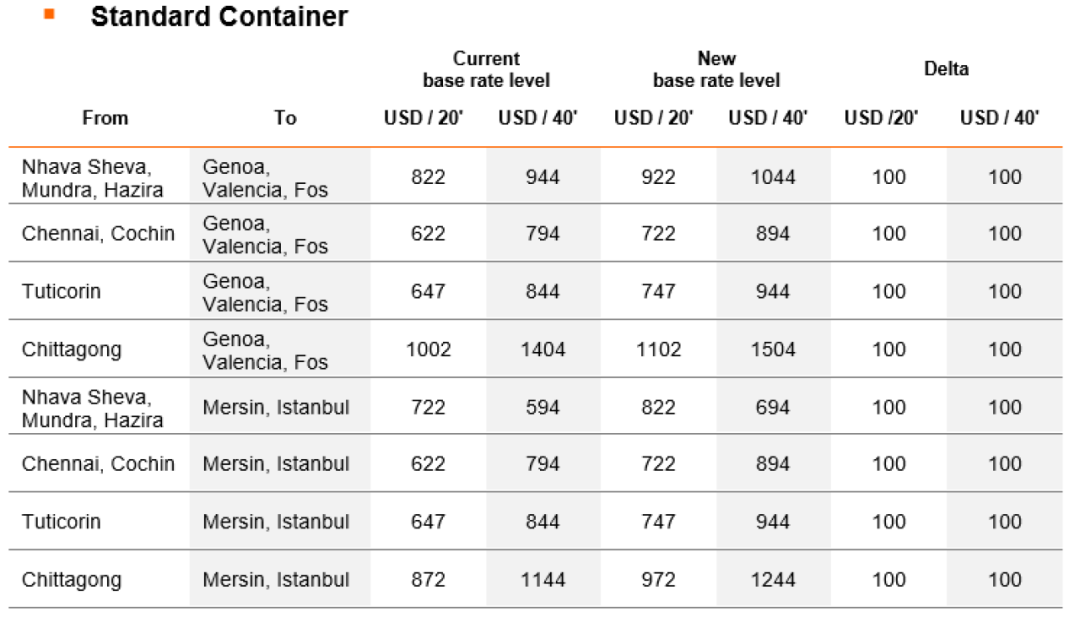Freight rates are still rising! Major shipping companies announce September freight rates
- Author:Chelsea
- Source:SEABAY
- Release Date:2020-08-23
September is coming soon! Some well-known shipping companies have already announced the freight rates for September, but the freight rates are still going up and up! ! !
What are the reasons behind this record-breaking surge and skyrocketing of ocean freight rates? What is right and wrong?
1. CMA CGM CMA CGM
CMA CGM has announced that starting from September 1st, all dry, refrigerated, out-of-gauge (OOG) and bulk cargoes from Asian countries to Africa and the Indian Ocean will resume general freight rates (GRR).
From China, South Korea and Taiwan
To all ports in West Africa
Unit: 500 USD/20' | 1000 USD/40'
From Southeast Asia and the east coast of India
To all ports in West Africa
Unit: 500 USD/20' | 500 USD/40'
From Asia, including China, South Korea, Taiwan, Southeast Asia, East Coast of India, Bangladesh and Sri Lanka
To East Africa, South Africa and the Indian Ocean
Unit: US$300/20' | US$600/40'
At the same time, CMA CGM also announced the latest freight rates (FAK) from all ports in Asia to multiple destination ports in the world, starting from September 1 (the date of shipment at the port of origin) until further notice (but not more than September 14) :
Major ports in Asia:



What are the reasons behind this record-breaking surge and skyrocketing of ocean freight rates? What is right and wrong?
1. CMA CGM CMA CGM
CMA CGM has announced that starting from September 1st, all dry, refrigerated, out-of-gauge (OOG) and bulk cargoes from Asian countries to Africa and the Indian Ocean will resume general freight rates (GRR).
From China, South Korea and Taiwan
To all ports in West Africa
Unit: 500 USD/20' | 1000 USD/40'
From Southeast Asia and the east coast of India
To all ports in West Africa
Unit: 500 USD/20' | 500 USD/40'
From Asia, including China, South Korea, Taiwan, Southeast Asia, East Coast of India, Bangladesh and Sri Lanka
To East Africa, South Africa and the Indian Ocean
Unit: US$300/20' | US$600/40'
At the same time, CMA CGM also announced the latest freight rates (FAK) from all ports in Asia to multiple destination ports in the world, starting from September 1 (the date of shipment at the port of origin) until further notice (but not more than September 14) :
Major ports in Asia:

Major ports in Asia:

All ports in Asia (including Japan, Southeast Asia, Bangladesh):

In addition, Marseille-based company announced a peak season surcharge (PSS) of 150 US dollars per container, applied to quarterly and long-term transactions, from all Asian ports (including Japan, Southeast Asia and Bangladesh) all Nordic ports (including the United Kingdom and Portugal, Finland and Estonia). The notice is valid from September 1 (the date of loading at the port of origin) until further notice, but shall not exceed September 30.
2.Hapag-Lloyd Hapag-Lloyd
The German company Hapag-Lloyd also announced new sea freight rates from the Indian subcontinent and East Asia to Northern Europe and the Mediterranean Sea, which will take effect on September 1.

2.Hapag-Lloyd Hapag-Lloyd
The German company Hapag-Lloyd also announced new sea freight rates from the Indian subcontinent and East Asia to Northern Europe and the Mediterranean Sea, which will take effect on September 1.

"We are currently seeing relatively high demand, but the supply of capacity is still limited, which is the key reason for the price increase," a Hapag-Lloyd spokesperson told Container News.
In addition, starting from September 1, the Hamburg route from East Asia to the east coast of South America, and from September 15 to the United States and Canada will implement price increases.
East Asia to South America East Coast
Unit: USD 1,000 per container
East Asia to North America (U.S. and Canada)
Unit: US$960/20' | US$1200/40'
It should be noted that East Asia defined by Hapag-Lloyd refers to Japan, South Korea, Taiwan, Hong Kong, Macau, Vietnam, Laos, Cambodia, Thailand, Myanmar, Malaysia, Singapore, Brunei, Indonesia, the Philippines, and the Russian Pacific. Coastal provinces and regions.
In addition, due to the continuous changes in market conditions affected by the Covid-19 epidemic, Maersk Line announced that it will increase its tariffs from September 15.
In addition, starting from September 1, the Hamburg route from East Asia to the east coast of South America, and from September 15 to the United States and Canada will implement price increases.
East Asia to South America East Coast
Unit: USD 1,000 per container
East Asia to North America (U.S. and Canada)
Unit: US$960/20' | US$1200/40'
It should be noted that East Asia defined by Hapag-Lloyd refers to Japan, South Korea, Taiwan, Hong Kong, Macau, Vietnam, Laos, Cambodia, Thailand, Myanmar, Malaysia, Singapore, Brunei, Indonesia, the Philippines, and the Russian Pacific. Coastal provinces and regions.
In addition, due to the continuous changes in market conditions affected by the Covid-19 epidemic, Maersk Line announced that it will increase its tariffs from September 15.
Behind this round of skyrocketing freight rates, what is right and wrong?
Industry analysts and analysts expressed their views and opinions from an objective perspective.
A: The recovery of domestic demand is the main reason
The most important driving factor for this record-breaking surge in ocean freight rates is the "compensatory" rebound in local market demand after the epidemic, or a "retaliatory" rebound.
The current level of import trade in the United States has returned to and exceeds the level before the epidemic, and the imported goods are mainly household goods, electronic products, fitness equipment, bicycles, etc. Some analysts believe that there are two reasons for the sharp increase in U.S. demand. In addition to the compensatory rebound in demand that has been suppressed by the epidemic for several months, and the advance inventory in response to the uncertainty of the future epidemic; the other is the US government during the epidemic. Subsidies to the unemployed, people have the ability to have cash to support purchase behavior.
B: The shipping company’s holes in the early stage are too big, so make up later
Because since the global outbreak of the new crown epidemic in March this year, the global shipping industry has suffered an unprecedented impact, and even caused a complete suspension of business. Many well-known shipping companies have suffered heavy losses, leaving a large number of accepting loopholes, and their annual performance goals have been affected. . However, as demand picks up, shipping companies have made compensatory price increases, which is actually a common market behavior.
C: Factors of structural shortage of container equipment
In addition to demand-driven factors, the short-term structural shortage of container equipment caused by the global shipping industry suspension tide has not yet been lifted, and a large number of containers are occupied, which is also one of the current sea freight drivers.
Industry analysts and analysts expressed their views and opinions from an objective perspective.
A: The recovery of domestic demand is the main reason
The most important driving factor for this record-breaking surge in ocean freight rates is the "compensatory" rebound in local market demand after the epidemic, or a "retaliatory" rebound.
The current level of import trade in the United States has returned to and exceeds the level before the epidemic, and the imported goods are mainly household goods, electronic products, fitness equipment, bicycles, etc. Some analysts believe that there are two reasons for the sharp increase in U.S. demand. In addition to the compensatory rebound in demand that has been suppressed by the epidemic for several months, and the advance inventory in response to the uncertainty of the future epidemic; the other is the US government during the epidemic. Subsidies to the unemployed, people have the ability to have cash to support purchase behavior.
B: The shipping company’s holes in the early stage are too big, so make up later
Because since the global outbreak of the new crown epidemic in March this year, the global shipping industry has suffered an unprecedented impact, and even caused a complete suspension of business. Many well-known shipping companies have suffered heavy losses, leaving a large number of accepting loopholes, and their annual performance goals have been affected. . However, as demand picks up, shipping companies have made compensatory price increases, which is actually a common market behavior.
C: Factors of structural shortage of container equipment
In addition to demand-driven factors, the short-term structural shortage of container equipment caused by the global shipping industry suspension tide has not yet been lifted, and a large number of containers are occupied, which is also one of the current sea freight drivers.
